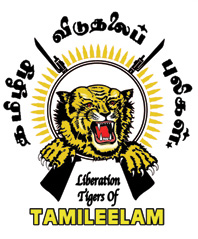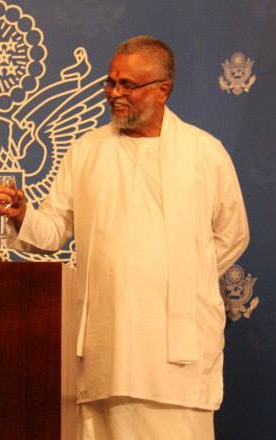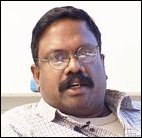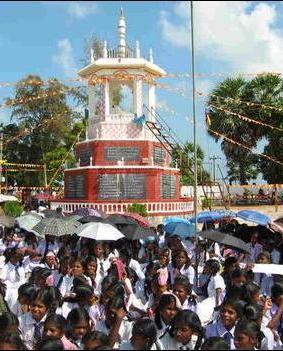
The Liberation Tigers of Tamil Eelam was a Tamil militant organization, that was based in the northern and eastern Sri Lanka. The LTTE fought to create an independent Tamil state called Tamil Eelam in the northeast of the island in response to violent persecution and discriminatory policies against Sri Lankan Tamils by the Sinhalese-dominated Sri Lankan Government.
The Eelam Revolutionary Organisation of Students (EROS), also known as the Eelam Revolutionary Organisers, is a former Tamil militant group in Sri Lanka. Most of the EROS membership was absorbed into the Liberation Tigers of Tamil Eelam (LTTE) in 1990. The other half of EROS that did not join forces with the LTTE due was led by PLO trained Shankar Rajee, Senior politburo member and military commander of EROS from 1990 until his demise in 2005. The political wing of 'EROS' is known as the Eelavar Democratic Front.

The People's Liberation Organisation of Tamil Eelam (PLOTE) is a former Tamil militant group that had become a pro-government paramilitary group and political party. PLOTE's political wing is known as the Democratic People's Liberation Front.

TamilNet is an online newspaper that provides news and feature articles on current affairs in Sri Lanka, specifically related to the erstwhile Sri Lankan Civil War. The website was formed by members of the Sri Lankan Tamil community residing in the United States and publishes articles in English, German and French.

Kathiravelu Nythiananda Devananda, commonly known as Douglas Devananda, is a Sri Lankan Tamil politician, Cabinet Minister and leader of the Eelam People's Democratic Party. Originally a Sri Lanka Tamil militant who fought against the Sri Lankan government for an independent Tamil Eelam, he became a pro-government paramilitary leader and politician. Due to his strong opposition to and vocal criticism of the rebel Liberation Tigers of Tamil Eelam, they unsuccessfully tried to assassinate him over 10 times. Devananda is a proclaimed offender in India and is wanted on charges of murder, attempt to murder, rioting, unlawful assembly and kidnapping. He was sworn in as Minister of Fisheries and Aquatic Resources on 22 November 2019.

Taraki Sivaram or Dharmeratnam Sivaram was a popular Tamil journalist of Sri Lanka. He was kidnapped by four men in a white van on 28 April 2005, in front of the Bambalapitya police station. His body was found the next day in the district of Himbulala, near the Parliament of Sri Lanka. He had been beaten and shot in the head.

Tamil Eelam is a proposed independent state that many Tamils in Sri Lanka and the Eelam Tamil diaspora aspire to create in the north and east of Sri Lanka. Large sections of the North-East were under de facto control of the Liberation Tigers of Tamil Eelam (LTTE) for most of the 1990s–2000s during the Sri Lankan Civil War. Tamil Eelam, although encompassing the traditional homelands of Eelam Tamils, does not have official status or recognition by world states. The name is derived from the ancient Tamil name for Sri Lanka, Eelam.
The Anuradhapura massacre occurred in Sri Lanka in 1985 and was carried out by the Liberation Tigers of Tamil Eelam. This was the largest massacre of Sinhalese civilians by the LTTE to date; it was also the first major operation carried out by the LTTE outside a Tamil majority area. Initially, EROS claimed responsibility for the massacre, but it later retracted the statement, and joined the PLOTE in denouncing the incident. The groups later accused the LTTE for the attack. Since then, no Tamil militant group has admitted to committing the massacre. However, state intelligence discovered that the operation was ordered by the LTTE's leader Velupillai Prabhakaran. He assigned the massacre to the LTTE Mannar commander Victor and it was executed by Victor's subordinate Anthony Kaththiar. The LTTE claimed the attack was in revenge of the 1985 Valvettiturai massacre, where the Sri Lanka Army killed 70 Tamil civilians in Prabhakaran's hometown. In 1988, the LTTE claimed that the massacre was planned and executed under the guidance of Indian intelligence agency, RAW.

On June 12, 1991, 152 minority Sri Lankan Tamil civilians were massacred by members of the Sri Lankan military in the village Kokkadichcholai near the eastern province town of Batticaloa. The Sri Lankan government instituted a presidential commission to investigate the massacre. The commission found the commanding officer negligent in controlling his troops and recommended that he be removed from office, and identified nineteen other members of the Sri Lankan military to be responsible for mass murder. In a military tribunal that followed in the presidential commission in the capital city of Colombo, all nineteen soldiers were acquitted.
Sri Lankan Tamil nationalism is the conviction of the Sri Lankan Tamil people, a minority ethnic group in the South Asian island country of Sri Lanka, that they have the right to constitute an independent or autonomous political community. This idea has not always existed. Sri Lankan Tamil national awareness began during the era of British rule during the nineteenth century, as Tamil Hindu revivalists tried to counter Protestant missionary activity. The revivalists, led by Arumuga Navalar, used literacy as a tool to spread Hinduism and its principles.
The Tamil Eelam Liberation Army was a Sri Lankan Tamil rebel group. TELA was originally the military wing of the Tamil Eelam Liberation Organization, but split away from TELO in 1982.
The Eelam National Democratic Liberation Front (ENDLF) is a former Indian backed Tamil militant group in Sri Lanka. It was formed in 1987 as an amalgamation of splinter groups from other militant groups. It is currently a pro-government paramilitary group and political party. In August 2011 it was reported that the party is to be deregistered.
The Eelam National Liberation Front (ENLF) was a short-lived (1984–1986) umbrella organisation for leading Sri Lankan Tamil militant groups.
The Lessons Learnt and Reconciliation Commission was a commission of inquiry appointed by Sri Lankan President Mahinda Rajapaksa in May 2010 after the 26-year-long civil war in Sri Lanka to function as a Truth and reconciliation commission. The commission was mandated to investigate the facts and circumstances which led to the failure of the ceasefire agreement made operational on 27 February 2002, the lessons that should be learnt from those events and the institutional, administrative and legislative measures which need to be taken in order to prevent any recurrence of such concerns in the future, and to promote further national unity and reconciliation among all communities. After an 18-month inquiry, the commission submitted its report to the President on 15 November 2011. The report was made public on 16 December 2011, after being tabled in the parliament.
The Indian intervention in the Sri Lankan civil war was the deployment of the Indian Peace Keeping Force in Sri Lanka intended to perform a peacekeeping role. The deployment followed the Indo-Sri Lankan Accord between India and Sri Lanka of 1987 which was intended to end the Sri Lankan civil war between separatist Sri Lankan Tamil nationalists, principally the Liberation Tigers of Tamil Eelam (LTTE), and the Sri Lankan Military.

Visvanathan Dharmalingam was a Sri Lankan Tamil politician and Member of Parliament.
Arumugam Murugesu Alalasundaram was an assassinated Sri Lankan Tamil teacher, politician and Member of Parliament.

Kadirgamapillai (Kathirkamar) Nallainathan was a Sri Lankan Tamil rebel and the founder and leader of the People's Liberation Organisation of Tamil Eelam (PLOTE), a separatist Tamil militant organisation in Sri Lanka.
Internet censorship in Sri Lanka is conducted under a variety of laws, judicial processes, regulations and more. In Sri Lanka, internet censorship is mostly executed by blocking access to specific sites as well as the use of laws which criminalize publication or possession of certain types of material, including regulations against terrorism and pornography.








